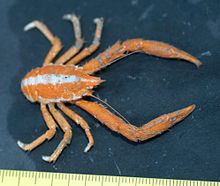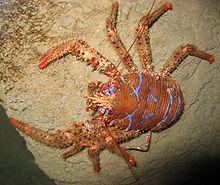- Squat lobster
-
Squat lobster
Temporal range: Middle Jurassic–Recent
Munidopsis serricornis (Galatheidae) Scientific classification Kingdom: Animalia Phylum: Arthropoda Subphylum: Crustacea Class: Malacostraca Order: Decapoda Infraorder: Anomura Superfamily: Galatheoidea Families Chirostylidae Ortmann, 1892
Galatheidae Samouelle, 1819
Kiwaidae Macpherson, Jones & Segonzac, 2005Squat lobsters are decapod crustaceans of the families Galatheidae, Chirostylidae and Kiwaidae, including the common genera Galathea and Munida. They are not lobsters at all, but are more closely related to porcelain crabs, hermit crabs and then, more distantly, true crabs. They are distributed worldwide in the oceans, and occur from near the surface to deep sea hydrothermal vents. There are currently 870 described species.[1]
Contents
Description and anatomy
Squat lobsters are much smaller than commercially-harvested true lobsters. For example, Munida rugosa has a maximum body length of 10 centimetres (4 in) with abdomen extended,[2] and the striated squat lobster Galathea australiensis has a carapace that reaches 15 cm (6 in) in length.[3]
The body of a squat lobster is usually flattened, the abdomen is typically folded under itself, and the first pereiopods (front legs) are greatly elongated and armed with long chelae (claws). The fifth pair of pereiopods is usually hidden within the gill chamber, under the carapace, giving squat lobsters the appearance of having only eight pereiopods.
Ecology and use by humans
Flesh from these animals is often commercially sold in restaurants as "langostino lobster," or sometimes called merely "lobster" when incorporated in seafood dishes.[4]
Munidopsis andamanica is a deep sea species that is specialized to feed only on sunken wood, including trees washed out to sea and timber from ship wrecks.[5]
Fossil record
Fossil squat lobsters have been found in strata dating back to the Middle Jurassic of Europe.[6]
Genera
There are 42 extant genera of squat lobsters, 7 in the family Chirostylidae, 34 in the Galatheidae, and Kiwa hirsuta alone in the family Kiwaidae:[7]
- Family Kiwaidae Macpherson, Jones & Segonzac, 2005
- Kiwa Macpherson, Jones & Segonzac, 2005
- Family Chirostylidae Ortmann, 1892a
- Chirostylus Ortmann, 1892a
- Eumunida Smith, 1883
- Gastroptychus Caullery, 1896
- Hapaloptyx Stebbing, 1920
- Pseudomunida Haig, 1979
- Uroptychodes Baba, 2004
- Uroptychus Henderson, 1888
- Family Galatheidae Samouelle, 1819
- Agononida Baba & de Saint Laurent, 1996
- Alainius Baba, 1991
- Allogalathea Baba, 1969
- Allomunida Baba, 1988
- Anomoeomunida Baba, 1993
- Anoplonida Baba & de Saint Laurent, 1996
- Babamunida Cabezas, Macpherson & Machordom, 2008
- Bathymunida Balss, 1914c
- Cervimunida Benedict, 1902
- Coralliogalathea Baba & Javed, 1974
- Crosnierita Macpherson, 1998
- Enriquea Baba, 2005
- Fennerogalathea Baba, 1988
- Galacantha Milne-Edwards, 1880
- Galathea Fabricius, 1793
- Heteronida Baba & de Saint Laurent, 1996
- Janetogalathea Baba & Wicksten, 1997
- Lauriea Baba, 1971
- Leiogalathea Baba, 1969
- Munida Leach, 1820
- Munidopsis Whiteaves, 1874
- Nanogalathea Tirmizi & Javed, 1980
- Neonida Baba & de Saint Laurent, 1996
- Onconida Baba & de Saint Laurent, 1996
- Paramunida Baba, 1988
- Phylladiorhynchus Baba, 1969
- Plesionida Baba & de Saint Laurent, 1996
- Pleuroncodes Stimpson, 1860b
- Raymunida Macpherson & Machordom, 2000
- Sadayoshia Baba, 1969
- Setanida Macpherson, 2006
- Shinkaia Baba & Williams, 1998
- Tasmanida Ahyong, 2007
- Torbenella Baba, 2008
References
- ^ Keiji Baba, Enrique Macpherson, Gary C. B. Poore, Shane T. Ahyong, Adriana Bermudez, Patricia Cabezas, Chia-Wei Lin, Martha Nizinski, Celso Rodrigues & Kareen E. Schnabel (2008). "Catalogue of squat lobsters of the world (Crustacea: Decapoda: Anomura — families Chirostylidae, Galatheidae and Kiwaidae)". Zootaxa 1905: 1–220. http://www.mapress.com/zootaxa/2008/f/zt01905p220.pdf.
- ^ "Rugose squat lobster Munida rugosa". The Marine Fauna Gallery of Norway. http://www.seawater.no/fauna/Leddyr/langfinger.htm.
- ^ "Striated squat lobster Galathea australiensis". Museum Victoria. 1996. http://www.mov.vic.gov.au/crust/mov92t.html.
- ^ David Sharp (October 3, 2006). "Maine senator attempts to blow whistle on 'impostor lobster'". Associated Press. http://archive.seacoastonline.com/news/special/10_3special.htm.
- ^ Matt Walker (November 11, 2009). "The deep-sea crab that eats trees". Earth News Article (BBC News). http://news.bbc.co.uk/earth/hi/earth_news/newsid_8353000/8353068.stm. Retrieved November 11, 2009.
- ^ Carrie E. Schweitzer & Rodney M. Feldmann (2000). "First notice of the Chirostylidae (Decapoda) in the fossil record and new Tertiary Galatheidae (Decapoda) from the Americas". Bulletin of the Mizunami Fossil Museum 27: 147–165. http://decapoda.nhm.org/pdfs/10787/10787.pdf.
- ^ Sammy De Grave, N. Dean Pentcheff, Shane T. Ahyong et al. (2009). "A classification of living and fossil genera of decapod crustaceans". Raffles Bulletin of Zoology Suppl. 21: 1–109. http://rmbr.nus.edu.sg/rbz/biblio/s21/s21rbz1-109.pdf.
Categories:- Squat lobsters
- Anomura
- Edible crustaceans
- Commercial crustaceans
Wikimedia Foundation. 2010.


